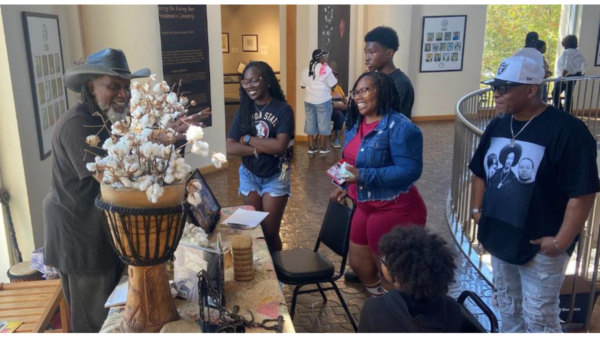By Norma Adams-Wade
By Norma Adams-Wade

When I think back, it comes across as maybe a clash of cultures.
To this day, I don’t really get the significance. After you read this, maybe you will inform me.
I’m writing this as some people prepare to observe the first day of May with traditional May Day activities. No, not the harrowing, three-time distress call for emergency help as in “May-day! Mayday! Mayday!” This one is the May Day that mainly elementary school students used to celebrate by plaiting the maypole on school playgrounds while dressed in frilly, bright-colored costumes. I’m told that some U. S. schools still observe some form of plaiting the maypole on May 1 May Day. I’ll take your word for it.
I was one of those students, way back in the day. I realize that a vast number of younger readers currently will have no clue what I’m talking about as I discuss May Day and plaiting the Maypole. Some elders may tell them it’s a multicultural folk festival. Some others may say it’s related to an early labor/workers movement. But let’s explore.
Whose idea was May Day in Dallas and globally?
I was just thinking…how did this 2,000-year-old pagan ritual — with alleged roots largely in ancient Rome, Germany, and Britain– end up as an annual celebration each May 1 in then-segregated Black public schools in Dallas, across the nation, and even globally?
I wonder who conceived the idea to make it a Dallas Public schools’ annual event –that included segregated, all-Black schools in low-income neighborhoods – and long before African drumming and dancing were acceptable. Researchers say many schools across the nation and in various countries held May Day festivities. Granted, students seemed to enjoy the ceremonies and the weeks of rehearsing how to entwine the attached maypole ribbons into intricate plait designs.
Here are some insightful references I found. Prolific performing arts critic, historian, blogger, essayist, lecturer, and broadcaster Alastair Macaulay made me feel less isolated in my wonderment. Macaulay is Anglo and presumably of Irish heritage. It was comforting to read one of his dance essays wherein he said that he, too, was a bit baffled about some of the cultural implications of May Day and maypole plaiting.
Here’s a portion of what Macaulay shares that gives the custom some African-based relevance along with other cultures.
“The history of the maypole dance is usually told as if it were entirely a European tradition. …The very idea seems…frightfully white,” Macauley writes in his 2021 Black History Month exploration about maypole dances around the world and in the African diaspora.
“My point is simply that …maybe in other Afro-Caribbean and African cultures, the maypole dance evolved to a peak of sophisticated complexity way beyond any known in European ballet.”
I commend Macaulay for his in- formed grasp of the importance of multicultural perspective in the arts – and, for that matter, life in general. The arts critic acknowledged that it could be true that the maypole dance originated in Germany, but he added this:
“The maypole dance is the national dance of St. Vincent in the Caribbean, to which it was reputedly introduced by slaves; maypole dances have been practiced in India, north Africa, and elsewhere.”
Other researcher report that that “elsewhere” includes an unexplained saturation in countries around the globe – including segregated, all-Black South Dallas during my elementary school years.

History of May Day celebration
Interestingly, research says the tradition of plaiting the Maypole goes back 2,000 years to Medieval times, invoking my wonderment about what the tradition had to do with my culture. Yes, surface information pointed to European culture and ceremonial pagan fertility folk dance rituals welcoming the advent of spring.
More research did suggest that parts of Motherland Africa devised our own cultural twists to the May-pole dance. Some historians even claim that parts of North Africa started the rituals before Europe.
Also, while plaiting the Maypole has largely faded across the globe, some researchers say the mod- ern-day Bahamas is the only location where the poleplaiting tradition persists throughout the year.

Trees were the first maypole
In medieval times, participants held on to ribbons and strips of cloth and danced around a tree decorated with flowers and greenery. The dances represented masculine and feminine energy promoting fertility in the new spring season.
Researchers say the plaiting formations can represent the entwining of feminine and masculine energy in fertile spring.
Later, a decorated pole that could be moved to various locations replaced stationary trees. Ropes, ribbons, and strings of cloth were twisted into intricate patterns around the pole called plaits – much like plaiting braids in coarse African hair.

Clash of culture or just plain fun?
So, was May Day and Black kids in Dallas a clash of cultures? Did some European administrator or descendant of Africa think the maypole was a clever idea for Dallas public school students? Was it maybe a hidden tribute to Motherland Africa where some researchers dare to contend the ritual started?
There is a photo in a photo album I inherited from my parents, Frank and Nettie Adams, showing my sister, Doris Serrell, and I dressed in May Day frills on the South Dallas street where our grandparents lived. We were headed to school that May 1 day to help plait the maypole.
Mayday! Mayday! Mayday! But no distress here.
Only fun memories of maybe someone else’s culture that I did not understand yet enjoyed celebrating on that first day of May.
Norma Adams-Wade, is a proud Dallas native, University of Texas at Austin journalism graduate and retired Dallas Morning News senior staff writer. She is a founder of the National Association of Black Journalists and was its first southwest regional director. She became The News’ first Black full-time reporter in 1974. norma_ adams_wade@yahoo.com.









You must be logged in to post a comment Login